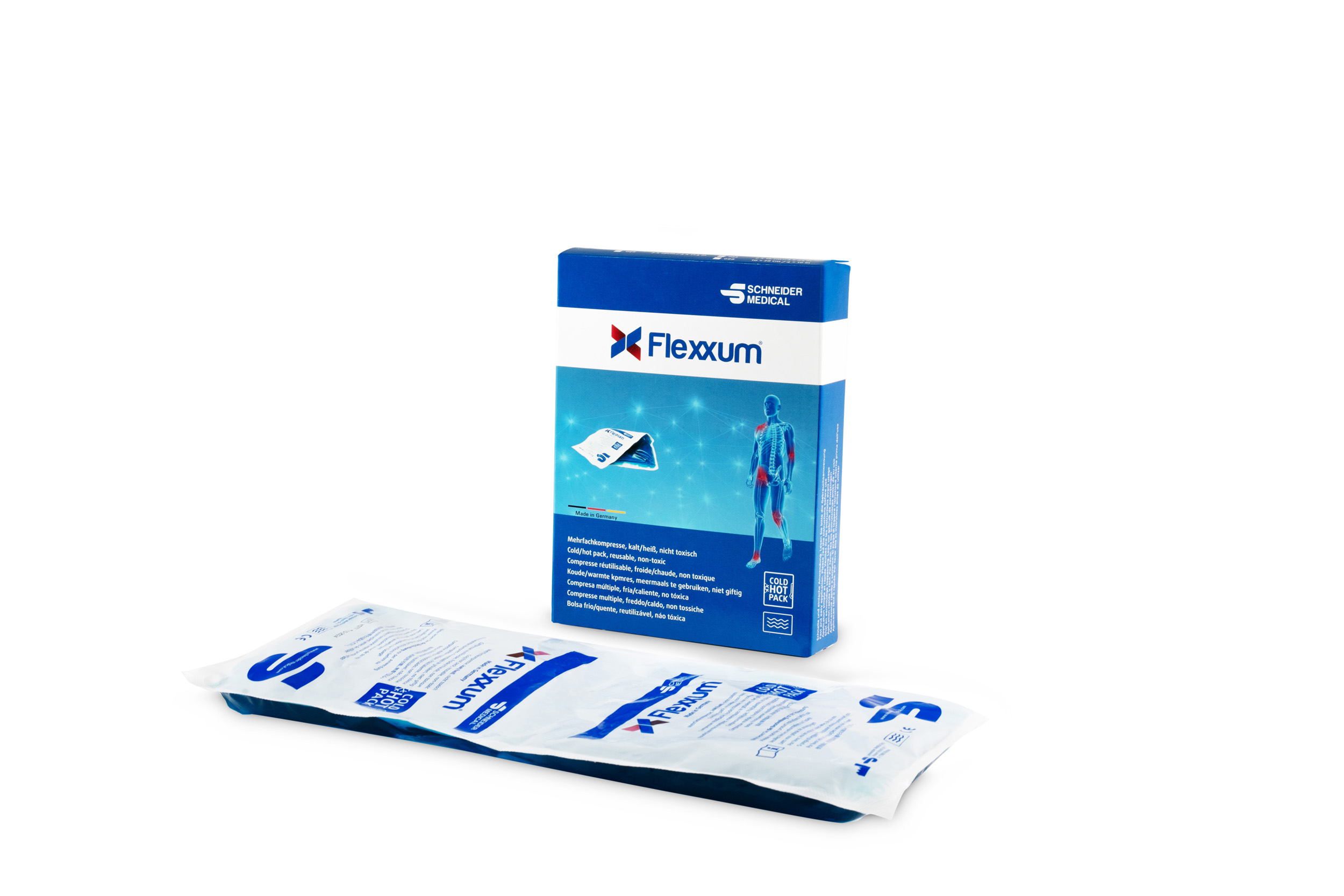Frohnradstraße 2
63768 Hösbach
Tel.+49 (0) 6021 62998-100
Fax +49 (0) 6021 62998-99
Cool packs
Injuries happen without notice! The fact that cold is an effective remedy for pain has been known for a long time and has been proven by studies. The anti-inflammatory and decongestant effect of cold is also undisputed. Especially after an injury, a suitable first aid measure is important to prevent a worse outcome. Cold packs are quickly at hand in injury situations and have a local effect on the painful area.
Filter products

Bag for ice cubes or hot water Ergonomic closure for easy opening and handling Suitable for the treatment of headaches, sprains, swellings, toothache etc. Adapts to the contours of the body Provides convenient and effective pain relief

Ideal for regeneration, lumbago or inflammation of muscles and joints Flexxum® brand multiple compresses offer the highest quality and safety even under high stress and strain. Flexxum® Hot/Cold Packs (multiple compresses) can be used hot and cold and retain the heat/cold for an above-average length of time. Product details: reusable many times (up to 400 times) long lifetime (5 years guarantee) and therefore lowest costs per application always remain flexible, even after a long time in the freezer the special coating on the polymer film prevents freezing in the freezer compartment Fields of application: Household Medicine Sport Possible applications for cold therapy: Bruises, sprains, strains Headaches Migraine Fever Pain relief Toothache Insect bites Bruises Tennis elbow Inflammations of muscles and joints Possible applications for heat therapy: Lumbago Sore muscles Back pain Abdominal pain Menstrual cramps
Different types of cold packs
Cold packs are available without pre-cooling as an immediate cold compress or as a multiple compress with storage in the refrigerator or freezer. Depending on the injury or healing process, it can be decided whether a lot of energy/heat must be extracted. Depending on the situation, cooling with an instant cold pack or a multiple compress from the refrigerator or freezer can be used. In all applications it is important that you always use a cloth to avoid the risk of hypothermia.
Instant cold compress
Instant cold compresses are bags that only need to be folded to trigger a cold effect within a few seconds. They remove heat from the environment and are quickly at hand and therefore ready for immediate use. Instant cold packs are usually designed for single use, which means that they cannot be reused once they have been activated by being folded.
Multiple compress
Unlike instant cold packs, gel-filled cold packs must be stored in the freezer or refrigerator. To achieve the desired cooling effect, it is necessary to keep the cold pack cold. The advantage of multiple cold packs is that they can be used again and again. Often, multiple compresses can also be used as a warm compress. To do this, simply place the compress in boiling water or in the microwave for a few minutes.
How do cold packs work?
Cooling with cold packs is an important first aid measure for many acute injuries, such as sprains, bruises, or contusions. Among other things, immediate cooling causes vasodilation (dilation of blood vessels). This means that the volume of the arterial (feeding) vessels is reduced, which consequently leads to a reduced "bleeding-in pressure". Less bleeding in means a decrease in swelling, so that less bleeding in needs to be "disposed of" in the next phases. At the same time, exposure to cold reduces blood flow. This inhibits the development of inflammatory reactions and leads to faster healing of the injury. Another important function of cooling is that it slows down the activity of receptors or nerve transmission and thus dulls pain.
Why are cold packs used?
Cold is one of the best-known immediate measures for injuries. The use of cold packs has numerous positive effects on the body. Among them are:
- Inhibition of blood circulation
- Reduction of fluid retention and swelling
- Modifying metabolic and inflammatory processes
- Pain relief
- Reducing muscle tone
You can use cold packs in the following cases:
- For pain relief
- After sports injuries (tennis elbow) and operations/span>
- For bruises, sprains and strains
- For inflammation of muscles and joints
- For haematomas
- For fever
- For toothache
- Backache
- For headaches or migraines
- For insect bites
How to cool properly!
Start cooling immediately after an injury so that the body can begin its auto reparative reactions. Acute cooling should only be applied for 15 to 20 minutes. Then interrupt the compression and do it again depending on the situation. The cooling phases can be repeated 2-3 times.
And important: take small cooling breaks during the acute phase!
Conclusion
Cold packs are practical everyday companions and can be used for acute injuries anytime and anywhere. All you need to do is put them in a cooler or the fridge and they can prevent injuries from getting worse. Always remember the PECH rule and take care of your body. However, with all injuries, it also makes sense to have them checked out by a doctor for insurance reasons.
